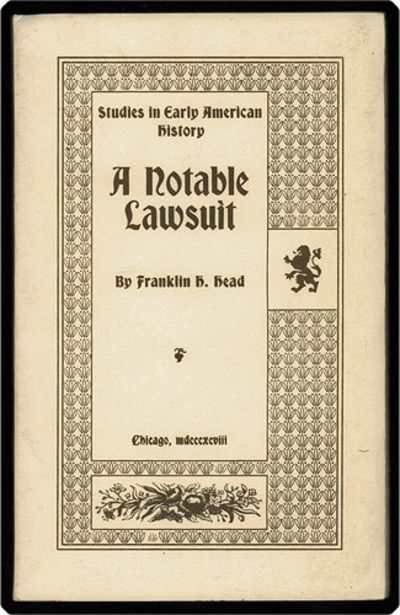
Head, Franklin H.
Studies in early American history: A notable lawsuit.
Portland, ME: Privately printed [by the Ascensius Press], 2002
- $75
Portland, ME: Privately printed [by the Ascensius Press], 2002. 12mo (18.1 cm, 7.12"). 37, [3] pp.; 6 plts.
Small-press facsimile of a literary jeu d'esprit written by => the founder of the Chicago Liars Club and originally printed in 1898. This account of a (completely fictitious) lawsuit claims that the Astor family fortune was founded on the discovery of Captain Kidd's long-lost treasure buried in a cave in Maine — on land owned by the Olmsted family, who upon discovering these facts went after the Astors for a share of the loot. The story actually gained traction as a part of Astor mythology, despite almost => every checkable detail being provably inauthentic!
The tale appears here in the spirit of shedding light on the truth, with commentary by prominent landscape architect Frederick Law Olmsted himself; this Ascensius Press printing is => illustrated with a total of six plates, including the faked "portrait" of John Jacob Astor.
The colophon inaccurately states, apparently continuing the joke, that 400 trade copies were printed in addition to 100 special copies, the present example being => numbered copy 41 of the 100 printed on handmade paper and hand-bound by the Maine-based press. Publisher's printed paper jacket over heavy cardstock wrappers. => A clean, crisp, lovely copy.
More from Philadelphia Rare Books & Manuscripts Co.
Lady Byron vindicated. A history of the Byron controversy, from its beginning in 1816 to the present time.
Stowe, Harriet Beecher. Boston, 1870 Boston: Fields, Osgood & Co., 1870. 8vo (18.2 cm, 7.16"). 6, [2], 482, [2 (blank)] pp. First edition of Stowe's impassioned — and highly unpopular — defense of the life and accomplishments of the late Lady Byron. Expanded from her 1869 article in The Atlantic Monthly, this book-length treatment of the subject attacks Lord Byron's conduct, his sanity, and his poetry. Provenance: From the collection of Robert Sadoff, M.D., forensic psychiatrist and director of Penn's Center for Studies in Social-Legal Psychiatry, sans indicia. BAL 19456. Publisher's purple cloth, covers framed in blind, spine with gilt-stamped title; very slightly cocked with spine sunned, minor shelfwear to extremities, and small spots of minor discoloration to sides. Pages evenly age-toned. => A clean, solid, very readable copy of a notoriously readable book.- $175
- $175
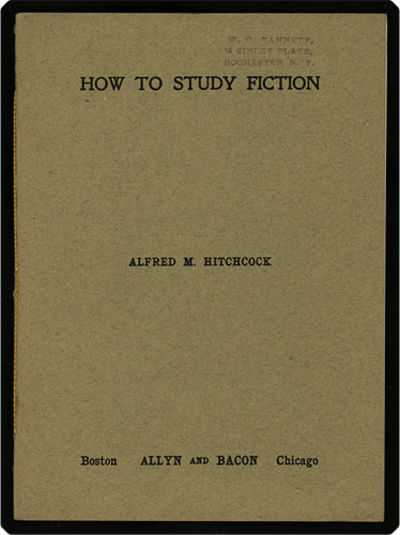
How to study fiction.
Hitchcock, Alfred M[arshall]. Boston & Chicago, copyright 1899 Boston & Chicago: Allyn & Bacon, copyright 1899. 16mo (15.6 cm, 6.14"). [2], 13, [1] pp. Scarce little educational pamphlet offering an overview of how to engage with a novel or story, written by a teacher at Hartford Public High School and aimed at students of that age range as well as at older people who might still find themselves "without a definite plan of study." A search of WorldCat finds => only one reported U.S. institutional holding (Harvard). Provenance: Front wrapper with rubber-stamp of William C. Gannett, clergyman and reformer; the Rev. Gannett and his wife ran a number of reading and study groups associated with the Unitarian Church in Rochester, NY. Sewn in publisher's printed paper wrappers; wrappers gently sunned and with rubber-stamp as above. => Crisp and clean.- $100
- $100
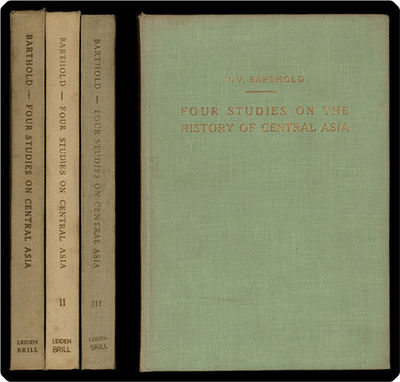
Four studies on the history of Central Asia.
Barthold, Vasily Vladimirovich [Wilhelm]; Vladimir & Tatiana Minorsky, transl. Leiden, 1956, 1958, & 1962 Leiden: E.J. Brill, 1956, 1958, & 1962. 12mo (19.6 cm, 7.71"). 3 vols. I: Frontis., xvi, 183, [1] pp. II: Frontis., xii, 200 pp.; 2 plts. III: vii, [1], 187, [1] pp.; 1 plt. First edition in English, translated from the original Russian and in three volumes as issued, with the first volume containing "A Short History of Turkestan" and "History of the Semirechyé," and the second and third volumes subtitled Ulugh-Beg and Mi?r ?Ali?-Shi?r: A History of the Turkman People. There are a total of five plates, including the two frontispieces. Publisher's light green cloth, front covers and spines with gilt-stamped titles; spines and board edges sunned. Pages clean.- $150
- $150
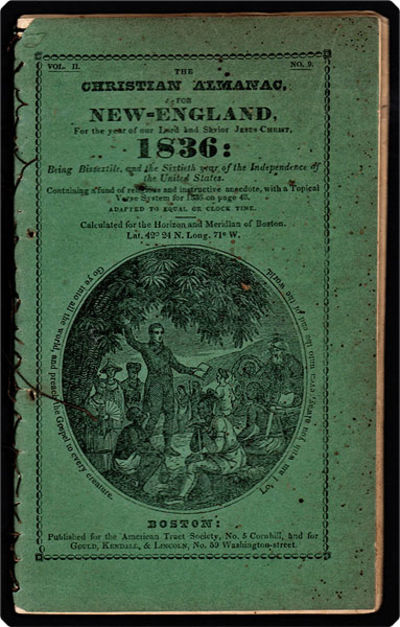
The Christian almanac, for New-England, for the year of our Lord and Savior Jesus Christ, 1836 … Adapted to equal or clock time … Calculated for the horizon and meridian of Boston. Lat. 42° 23’ N. Long. 71° W.
American Tract Society; Anderson, Alexander, illus. Boston, 1835 Boston: Pub. for the American Tract Society and for Gould, Kendall, & Lincoln, 1835. 8vo (17.6 cm, 6.92"). 47, [1], [16 ms.] pp. Vol. II. No. 9" of this long-running almanac from the American Tract Society; p. 3 states that the calculator was David Young. This issue is graced with both a large title-page vignette showing Jesus teaching and, on the front wrapper, another vignette of a contemporary missionary preaching to an emblematic (not realistic) gathering of the world's peoples, both done by => renowned wood-engraver Alexander Anderson. This almanac was once bound with other items in a nonce volume, and the one that followed it there is still present — being a signature of 8 blank leaves of which =>15 pages are filled or nearly filled with brief diary entries, almost if not quite day-by-day, for the year 1836. Names and places suggest the record was made in Maine; the matter is divided under the heads of "Weather" and "Items"; the writer is apparently male and enjoyed his first wedding anniversary in May. Drake, Almanacs, 4101; Pomeroy, Alexander Anderson, 1331 & 1664 (see also 1093). Publisher's blue-green printed paper wrappers, vignette as above; spine strengthened by old over-sewn stitching, manuscript section now separated. The whole with old creasing and dog-earing to both portions, some shallow and some deep, and with light soiling only. => A most engaging two-fer.- $48
- $48
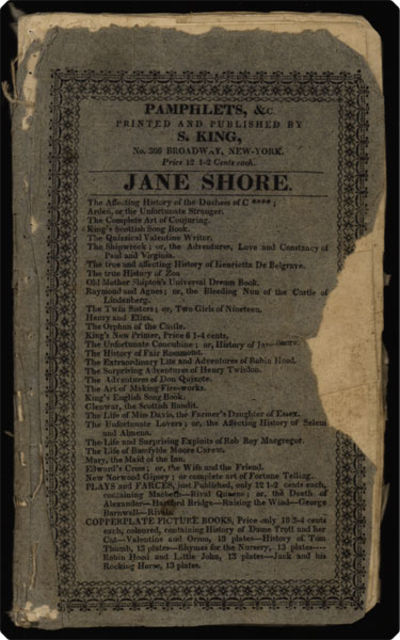
The unfortunate concubine; or, history of Jane Shore, mistress to Edward IV. King of England.
(Jane Shore). Prudhomme, John Francis Eugene, illus. New York, 1822 New York: S. King, 1822. 12mo (19.5 cm, 7.67"). Col. frontis., [2], [9]–34 pp. Showing how she came to be concubine to the king; with an account of her untimely end": An uncommon early 19th–century American printing of the ever-popular story of Jane Shore. This version opens with => a delicately hand–colored frontispiece showing an attractive (if anachronistic) lady in Regency dress, signed "E. Prud'homme," i.e., the esteemed artist and banknote engraver John Francis Eugene Prud'Homme. The front wrapper advertises a list of other S. King pamphlets. Shoemaker 10502. Publisher's printed paper wrappers, roughly sewn, with previous sewing holes showing; sections of chipping to edges, affecting the fore-edge of the front wrapper rather deeply taking border but not text. Pages age-toned with edges untrimmed, moderate foxing and variable staining; frontispiece with old repair to outer edge, small area of insect damage in upper inner margin. => A scarce production, with a nice example of Prudhomme's early work.- $300
- $300
Little journeys to the homes of American authors: Lowell.
Briggs, Charles F. New York & London, 1896 New York & London: G.P. Putnam's Sons; New Rochelle: The Knickerbocker Press, 1896. 12mo (17.4 cm, 6.85"). [2], 123–148, [8 (adv.)] pp. Vol. II, no. 4 in a monthly series offering a new printing of Putnam's popular Homes of American Authors series of 1853, with the present example looking at the childhood home (and subsequent life) of Massachusetts-born poet James Russell Lowell. The title-page of this little Knickerbocker Press production is printed in red and black. => Scarce as a solo appearance thus. Stapled in self-wrappers as issued. => Fresh and clean.- $75
- $75
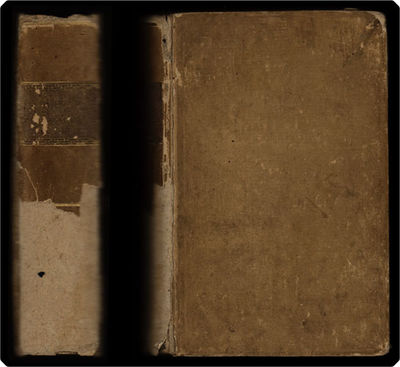
Gedichte von Friedrich Wilhelm August Schmidt. Mit Kupfern und Music.
Schmidt, Friedrich Wilhelm August. Berlin, 1797 Berlin: Haude und Spener, 1797. 12mo (13.5 cm, 5.31"). Engr. t.-p., iv, 306 pp. (pp. 303–06 bound between 286 & 287); 15 plts. (5 col.). Elegant little printing of these pieces from a poet known for focusing on the simple joys of rural life — and for being mocked for that by Goethe, who did acknowledge, however, that Schmidt showed genuine poetic merit. The minute but legible text is graced with => a copper-engraved title-page, 15 attractive copper-engraved plates, and two folding leaves of sheet music for settings of "An den Mond" and "Liebe," composed by Johann Friedrich Reichardt. In this copy, => five of the engravings are skillfully and subtly hand-colored, four of those having been excised and mounted (sans captions) back in the appropriate places. This is the second edition, following the first printed by Spener in 1795; the text has been => completely reset, appearing here in roman type rather than the fraktur of the first edition. Provenance: From the library of American collector Albert A. Howard, small booklabel ("AHA") at rear. VD18 11236914 (for 1795 ed.). Contemporary tan paper–covered boards, spine with gilt-stamped title-label; cocked, rubbed overall, spine paper largely lost and label rubbed with lettering all but lost. Pastedowns with small adhered spots of blue paper, and title-page partially separated; most guard leaves present, some crumpled; mild to moderate foxing to pages. Worn condition notable; still => a production and a copy both appealing and worthwhile.- $550
- $550
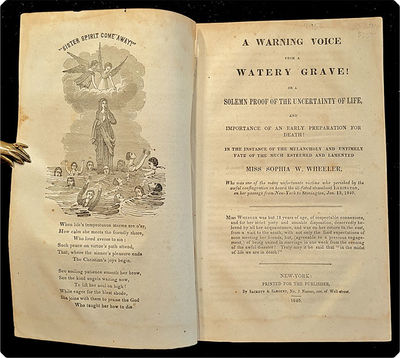
A warning voice from a watery grave! Or a solemn proof of the uncertainty of life, and importance of an early preparation for death! In the instance of the melancholy and untimely fate of the much esteemed and lamented Miss Sophia W. Wheeler.
[Weild, C.]. New York, 1840 New York: Pr. for the publisher by Sackett & Sargent, 1840. 8vo (21.7 cm, 8.54"). 24 pp.; illus. Just 18 years old and about to be married, Wheeler was "one of the many unfortunate victims who perished by the awful conflagration on board the ill-fated steamboat LEXINGTON, on her passage from New-York to Stonington, Jan. 13, 1840" (per the title-page). Here, the untimely end of the Massachusetts native — and almost everyone else aboard the luxury vessel — provides a cautionary tale to Christians in need of preparing themselves for eternity. => This sole edition of "A Warning Voice" opens with the poem "Sister Spirit Come Away," illustrated with a wood-engraved scene of angels watching over the victims as they drown; a poem written by Eliza Perkins. Portions of several other poems about the catastrophe are included, one written specifically for Sophia, and one that begins "Death follows in the wake of Time and sweeps / Away the aged and the blooming young." Also present are lists of officers, crew, and passengers of the Lexington, and an account of the various ways in which they perished. The authorial attribution comes from the copyright information. This item is => scarce, with very few institutions reporting hard-copy holdings. Sabin 101453; American Imprints 40-6819. Removed from a nonce volume; sewing going, with some leaves all but separated. Upper and lower edges waterstained, into margins but not text; pages age-toned overall with occasional foxing.- $250
- $250
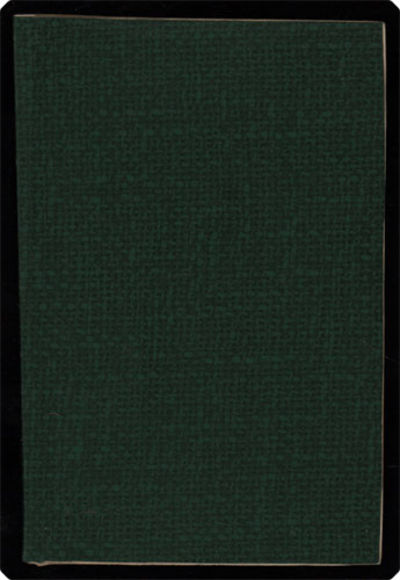
The autobiography of William Love, P.C. a native of Paisley, better known as the Roving Scotchman, the greatest traveller alive!
Love, William [pseud.]. Paisley, 1857 Paisley: G. Caldwell, 1857. 16mo (15.5 cm, 6.1"). Frontis. (incl. in pagination), pp.; illus. Satirically dedicated to the Paisley Literati, this is the comic life story of a traveling peddler, "containing an account of his birth, parentage, and education, travels to remarkable places, love adventures, opinions on things in general, with philosophical remarks on particular subjects" — and breaking into => occasional font exuberance to emphasize highlights. The text is illustrated with a whimsical engraved frontispiece portrait captioned "Magnus est amicus et praevalebit" and two in-text vignettes. A search of WorldCat finds => only three reported hard copies of this sole edition in U.S. institutions. Provenance: Inside front wrapper with printed ex libris label of J.L. Weir. Later paper wrappers; frontispiece with outer edge just slightly shaved, title-page with small inked numeral by imprint, last page evenly browned. => A nice copy of an uncommon item.- $100
- $100
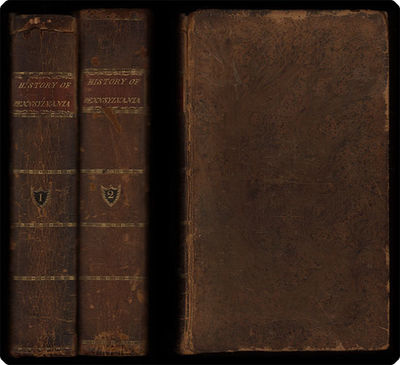
The history of Pennsylvania, in North America, from the original institution and settlement of that province, under the first proprietor and governor William Penn in 1681, till after the year 1742.
Proud, Robert. Philadelphia, 1797-98 Philadelphia: Zachariah Poulson, Jr., 1797-98. 8vo (21.5 cm, 8.5"). 2 vols. I: 508 pp., [1] leaf of plates (portrait). II: 373, [1], 146 p., [1] folded map. An important and standard late 18th-century history of Pennsylvania by a native of Yorkshire, England, who settled in Philadelphia in 1759 and remained there (here!) until his death in 1813. In addition to its standard fare (i.e., "The history of Pennsylvania, 1676–1709"; "The history of Pennsylvania, 1709–1763"; "A view of the province of Pennsylvania ... between the years 1760 and 1770"), the work's appendix includes "Certain Conditions, or concessions, agreed upon by William Penn," "The Frame of the Government of the Province of Pensilvania, 1682, 1683, 1696," "The Charter of the City of Philadelphia, 1701," and the "Journals of Christian Frederick Post, from Philadelphia to the Ohio, 1758–59." John James Barralet (approx. 1747–1815) supervised Alexander Lawson (1773–1846), the engraver of the William Penn portrait that serves as the frontispiece to vol. I, and James Thackara (1767–1848) was the engraver of the map in vol. II. Binding: Contemporary tree calf, spines divided into compartments by attractive and thoughtful gilt tooling; red leather title-labels with additional delicate gilt bordering. Volume numbers gilt to small black leather shields defined by additional modest gilt. Provenance: Hannah Ann Morris Buckley on fly-leaf of vol. I; signature of Sarah Wistar in top blank area of each title-page. The Morris and Wistar families were important Philadelphia families and much intermarried. Sowerby, Catalogue of the Library of Thomas Jefferson, 460; Evans 32729, 34421; ESTC W020454; Howes P 639; Sabin 66223. Bound as above, volumes scuffed with joints outside starting to open from tops yet solid. Foxing and age-toning as would be expected, only; map in good condition. => Overall, a very nice set.- $600
- $600
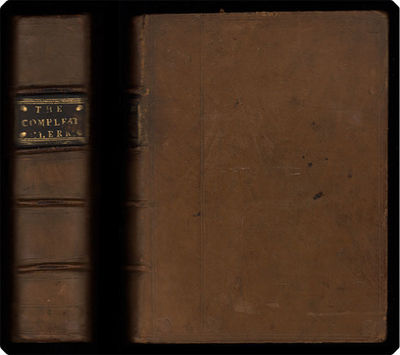
Compleat clerk containing the best forms of all sorts of presidents, for conveyances and assurances.
H., J. [i.e., John Herne?]. London, 1677 London: Pr. by G. Sawbridge, T. Roycroft, & W. Rawlins for H. Twyford et al., 1677. 8vo (23.5 cm, 9.25"). [4], 936, [80] pp. Important legal reference work here in its fourth, expanded, 1677 edition, following the first of 1655. The text is printed in roman, italic, and blackletter with typographic headpieces; one page bears an illustration of the notary's mark on an "antient" resignation (p. 599). The present copy lacks the additional engraved title-page dubbing the work "The Conveyancers Light," but does include the appendix of titles, cities, weights, and personal name variants in Latin, the glossary of obsolete words, and the table of kings' reigns, as well as => "The several Parts of the Bodies of Men, Women, Children, Beasts, Birds, Trees, Plants, Hearbs . . . both in Latine and English. The like whereof hath never been done before, and will be much for the ease and benefit of the Attorney and Clerk." Provenance: Front pastedown with armorial bookplate of Richard Hopton of Canon Frome, Hereford; and with ownership inscription of I.A. Shapiro, noted scholar of 17th-century literature. Wing (rev. ed.) C5636A; ESTC R25473; Sweet & Maxwell, I, 480:16. Contemporary calf, framed and panelled in double blind fillets with blind-tooled corner fleurons, spine with blind-ruled raised bands and gilt-stamped leather title-label, board edges with gilt roll; small scuffs and some rubbing to binding with a few pinhole spots of insect damage to spine. Front pastedown with bookplate and inscription as above, additional engraved title-page lacking, title-page with small early inked annotation in lower portion; text age-toned with offsetting and foxing ranging from faint to moderate. One leaf with short tear from outer margin, not touching text; one leaf with small repair in upper outer margin. => A sturdy, usable copy in a dignified contemporary binding.- $1,500
- $1,500

Typed Letters Signed.
Bailey, Albert William. Rhodesia & Angola, 1912–1921 Rhodesia & Angola, 1912–1921. Folio (34.29 cm, 13.5"). [32] pp.; 1 photo.. Large-format album of 16 missives from the Rev. Albert William Bailey (1873–1955), Baptist missionary to Africa and leader of the first attempt to establish a Christian mission among => the Nkoya. The collection opens with a black and white photographic portrait of Bailey, followed by 14 letters variously addressed to his brother, son, and friends, and two typed manuscripts entitled "A Promise Redeemed" (ca. 1914) and "A Shaking Among the Bones" (ca. 1918). Along with accounts of his preaching, his school and the students there, his work on => translating the Gospel of John into the Mbunda language, and his day-to-day experiences (including cobra encounters!), the letters include thoughts on mission and church finances, American politics (particularly the presidential election), and crime in New York — as well as an assurance to his son that yes, he had seen crocodiles, although not yet shot one. Most of the letters are typed, with handwritten signatures, postscripts, and occasional corrections, while one is entirely handwritten. Two notable running themes are Bailey's unshakable conviction in the importance of his work in Africa, and the complexity of his long-distance relationship with his son (left behind in America with his aunt and uncle), whom he alternately praises and criticizes; one letter acknowledges with sadness and resignation that the beloved but wayward Paul has left the Baptist church in favor of "the Universalists." Overall, this is => a remarkable look at the work of an influential missionary then at his peak. 20th-century mustard-colored leather–covered album; minimal shelfwear. Page sleeves and backings age-toned; one sleeve starting to split from foot of inner margin. Letters age-toned with occasional edge chips. => Unique and fascinating.- $900
- $900
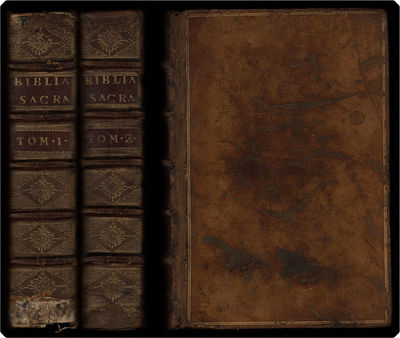
Sacra Biblia vulgata editione, translat. ex Hebraeo sanctis Pagnini, transl. Romana ex Septuag. & Chaldaicae paraphrasis transl. congesta fratris Fortunati Fanensis Ordinis erem. S. Augustini studio et labore.
Bible. Latin. Vulgate. 1609. Venetiis, 1609 Venetiis: Apud Antonium Pinellum, 1609. Folio (29.6 cm, 11.65"). 3 vols. in 2. I: [24], 1102, [2] pp. II: [8], 674 (i.e., 678, some pagination repeated), [10], 326, [34 (index)] pp. Fortunato Scacchi's edition, from the press of eminent Venetian printer Antonio Pinelli. These volumes present the Vulgate Latin version of the Pentateuch alongside Latin translations from the Hebrew (done by Pagninus), from the Septuagint (by Flaminio Nobili et al.), and the "Chaldee" paraphrase (as in the Antwerp Polyglot), laid out in four parallel columns across two pages. Joshua through Ezra appear in parallel columns with the Septuagint across the foot of each page, per the Vulgate and Pagninus, with subsequent books being variously given in that layout or with the Vulgate and Septuagint side by side; and the New Testament is given in the Vulgate and in the translation from the Syriac by Guido Fabritius Boderianus (Guy Le Fe?vre de La Boderie). Each volume opens with an engraved title-page in an architectural border, highlighting the arms of Cardinal Scipione Borghese. The text columns are set in alternating roman and italic type, with ornamental capitals and attractive woodcut tailpieces; the title-pages (including the separate New Testament title) are printed in red and black, and the colophons feature the Pinelli tree device in an elaborate frame. Binding: Mid-18th centry mottled sheep, covers framed in gilt double fillets and board edges gilt also; spines with gilt-stamped leather title and volume labels, raised bands, and gilt-extra compartments in filigreed, beaded patterns. The unusual, striking endpapers are of mauve paper gilt-stamped in an ornate pattern of acanthus leaves, pomegranates, and assorted flowers. Thanks to Sandrine Hermine Salières-Gagloff for identifying the paper as from the atelier of Iohann Wilhelm Meyer. II, of Ausgburg and dating from ca. 1755. All page edges marbled. See Darlow & Moule 6201. Bound as above with sides scuffed, joints and edges rubbed; vol. I spine head pulling away and foot leather chipped partially revealing binding structure, vol. II with joints and spine extremities nicely refurbished. Vol. II with hinges (inside) and one leaf's margin neatly reinforced some time ago, and endpapers unevenly faded; vol. I and II title-pages and vol. I colophon mounted. Instances variously of small marginal worming or spotting; of short tears, closed or affecting a border or a few letters only; and of light waterstaining with a few leaves actually browned. One page with substantive annotation in Latin. => An edition not widely held institutionally, here in an impressive set.- $1,850
- $1,850
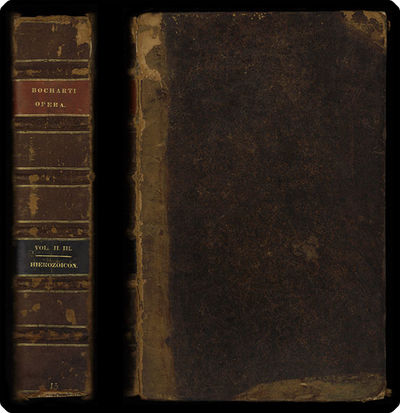
Hierozoicon, sive bipartitum opus de animalibus s. scripturae.
Bochart, Samuel. Lugduni Batavorum, 1712 Lugduni Batavorum: Apud Cornelium Boutesteyn & Samuelem Luchtmans, 1712. Folio (39.5 cm, 15.5"). [8], 63, [1] pp., 1094 cols., 91 (index), [3] pp., 888 cols., 79 (index), [1] pp.; illus. (lacking 1 prelim. f. & 1 plt.). Early, handsome edition of this treatise on the animals of the Bible, written by an eminent French Protestant biblical scholar, natural historian, and student of Oriental languages. The Hierozoicon was first published in 1663 and widely acclaimed at the time for its erudition and its => comprehensive presentation of classical material relating to every creature mentioned in Scriptures; it appears here in its stated fourth edition, originally issued as vols. II and III of Bochart's Opera omnia with spine labels reflecting that. This large volume's title-page is printed in red and black and features an attractive engraved vignette, as does the separate title-page of the second portion, while the text is printed in => Latin, Hebrew, Greek, and Arabic. Brunet, I, 1022 (for Opera). Contemporary mottled calf, rebacked in the 19th century with sheep, spine with gilt-stamped red and black leather labels; worn overall, sides scuffed, leather chipped and cracking, joints tender and starting from extremities. Front pastedown with small institutional bookplate, preliminary leaves with pencilled and (small) inked numerals, title-page institutionally rubber-stamped (quite neatly, and volume properly deaccessioned). Light to moderate foxing largely confined to margins, light soiling as of old use; in fact a clean, attractive volume. As noted, not present here is the other volume of Bochart's Opera; also lacking are the one-page "Praefatio praemissa editioni anni CICICCXCII" (not found in all copies) and the engraved portrait of the author. => This Hierozoicon is textually complete in and of itself.- $800
- $800
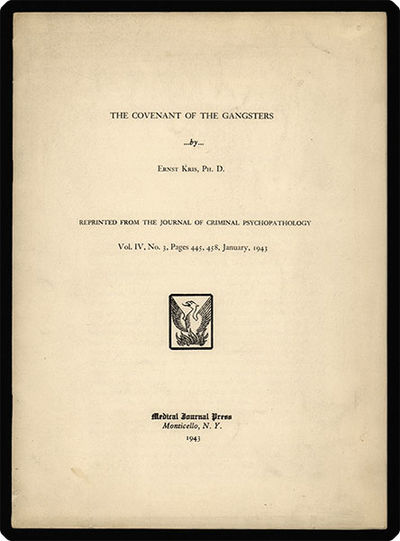
The covenant of the gangsters.
Kris, Ernst. Monticello, NY, 1943 Monticello, NY: Medical Journal Press, 1943. 8vo (26 cm, 10.23"). [445]–58, [2 (blank)] pp. Thrillers and motion pictures have familiarized a world-wide audience with some of the psycho-dynamics of the criminal group": This scarce offprint from the Journal of Criminal Psychopathology (vol. IV, no. 3, January 1943) makes use of the idea of complicity in gang dynamics to examine "the psychological manipulation to which the leaders of Germany are subjecting the German people" (p. 445), particularly the strategy behind anti-Jewish rhetoric prior to 1942. Dr. Kris (1900–57) was an Austrian-born psychoanalyst who fled to England after Hitler's invasion of Austria, eventually settling in New York and becoming a professor at the New School of Social Research. => Not only is this offprint uncommon, the text itself is seldom encountered and does not appear to have been reprinted elsewhere. Publisher's printed paper wrappers, wrappers faintly age-toned and dented. Unobtrusive small dents along lower edges, pages otherwise fresh and clean.- $50
- $50
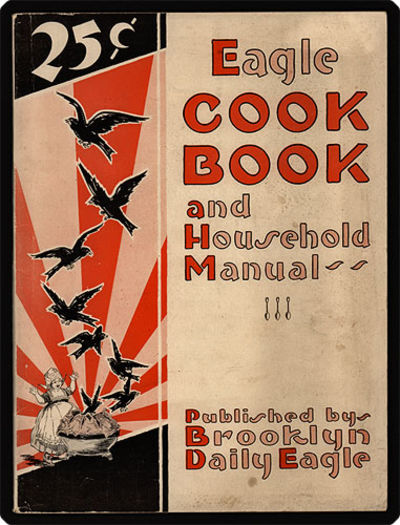
The Eagle cook book and household manual.
Hufcut, Rebekah S. New York, copyright 1928 New York: Brooklyn Daily Eagle, copyright 1928. 8vo (26.1 cm, 10.27"). 112 pp.; illus. Sponsored and published by the Brooklyn Daily Eagle, this magazine-format cookbook (vol. XLIII, no. 2 of the Eagle Library, serial no. 274) offers "general recipes" along with suggested menus for seasonal breakfasts, luncheons, and dinners, as well as special occasions, school lunches, and midnight suppers. The recipes are interspersed with advertisements for Cox's Gelatine, the Great Atlantic & Pacific Tea Co. (better known as A&P), Hecker's Flour, Scranton & Lehigh Coal Co., the Sylvan Electric Bath, and a large number of Brooklyn-area banks; one ad for a driving school offers "Special Ladies' Classes" to "learn to drive through traffic" (p. 106), while the Prudence Company pitches its Women's Investment Service and the Lamb's Business Training School proclaims "every graduate placed" after training in shorthand, touch typing, filing, bookkeeping, and secretarial practice — these advertisements providing => an interesting contrast to editor Hufcut's stated principle that "Woman's place is in the home." Hufcut was director of the Home Economics Department of the Young Women's Christian Association of Brooklyn; her biography page here notes that she "comes from that sturdy mid-Pennsylvania stock that for generations knew and appreciated the best in life" (p. 5). Publisher's color-printed paper wrappers, front one with Dutch child and blackbird-containing pie illustration; wrappers showing light wear overall, slight dust-soiling. Small area of bump/tear-damage to lower outer margins of perhaps a dozen leaves, one with part of a closed tear running into print area, without loss of text; otherwise, expectable age-toning only. => A scarce survivor, in very usable, browseable condition.- $150
- $150
Crime and punishment.
Dostoevsky, Fyodor. New York, 1948 New York: The Limited Editions Club, 1948. Large 4to (28.3 cm, 11.25"). 2 vols. 660 pp. This famous novel is offered here in two volumes in the translation of Constance Garnett, with an introduction by Lawrence Irving and with => extensive woodcut illustration by Fritz Eichenberg, as printed largely from the original blocks prepared for the electroplate Heritage Club edition of 1938. (The relationship-story of the two editions is recounted in the LEC's Monthly Letter that is included in this offer.) Binding: Quarter dark brown cloth over red linen sides, each volume with a red leather cover label stamped in gold leaf with a design of Eichenberg's. All edges sprinkled red. Thedition is limited to 1500 copies. Bound as above, slipcase lacking and vol. II with a slim streak of discoloration to spine label along rear joint; Monthly Letter a bit limp, with crumpling and staining, but present and informative. => Text very clean and good, illustrations crisp and lovely.- $125
- $125
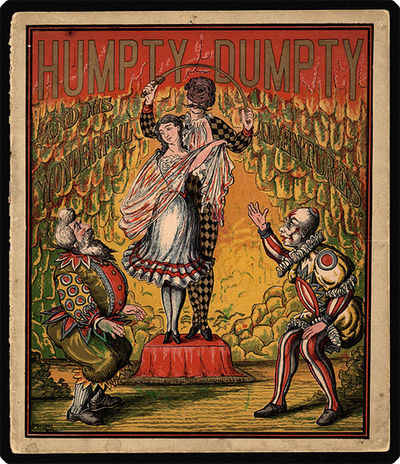
Humpty Dumpty and his wonderful adventures.
Geyser, J.B., illus. [Cincinnati, 1881?] [Cincinnati: Peter G. Thomson, 1881?]. Large 4to (27.1 cm, 10.66"). 8 ff.; col. illus. This Humpty is a clown rather than an egg, due to falling afoul of a passing fairy. His roguish escapades — which culminate in being eaten by a whale! — are told in verse and illustrated with => a vividly colored cover and six full-page illustrations chromoxylographed from designs by J.B. Geyser, the cover additionally enhanced with gilt-stamping. Unlike at least one digitized copy, the present example of this toybook does not bear Thomson's information at the foot of either the front or the back wrapper (the back wrapper here substitutes "For sale by all booksellers"), but the text and illustrations otherwise match that printing. Hard copies of this 19th-century printing are scarce: a search of WorldCat finds only six U.S. institutions reporting holdings (Monmouth County Historical Association, New York Public, New York State Library, UCLA, University of Florida, Yale). Publisher's tan paper wrappers, front wrapper pictorially stamped in color and gilt, back wrapper with publisher's advertisement; wrappers slightly darkened with smudges to outer margins and spots of discoloration to back wrapper, spine starting to split. Scattered small spots to pages. => Slightly fragile overall, but an impressively bright, engaging, and desirable item.- $450
- $450
Broadside, begins: Estadistica de los asuntos en que se ha ocupado el tribunal superior de justica y corte de apelaciones durante el año de 1871.
Guatemala. Tribunal de Justicia y Corte de Apelaciones. Guatemala, 1872 Guatemala: [Tribunal de Justicia y Corte de Apelaciones], 1872. Folio (73 x 56 cm, 30" x 21.75"). [1] f. The Supreme Court and Court of Appeals here on a => very large broadside summarizes the cases it adjudicated in 1871: criminal and civil, final decisions and appealed decisions, occupations of the defendants and appellants, and types of crimes, with data as to original jurisdiction of the cases, etc. Printed on "newspaper" stock and a bit fragile. Folded and with fold tears.- $125
- $125
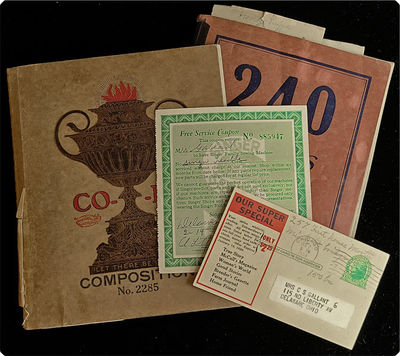
Manuscript on paper, in English.
Gallant, C[harles] S[purgeon], Mrs. Delaware, OH, 1929–30 & 1937–38 Delaware, OH, 1929–30 & 1937–38. 4to (21.27 cm, 8.375"). 2 vols. I: [84 (78 used)] pp. II: [240 (100 used)] pp.. Early 20th-century Ohio life captured in a wealth of minutiae: Two volumes of a journal kept by an older, middle-class woman, offering daily records of her sewing, quilting, baking, cooking, canning, churchgoing, aid society efforts, and other domestic activities, along with descriptions of the weather and references to current events (including a passing mention of one of the worst prison fires in American history: the 1930 Ohio State Penitentiary fire, in which 320 prisoners were killed) — all recorded in two different composition books. Notable threads trace => a powerful lot of visiting, in (and from) the Gallant house — those familiar with family names of the region will find much to recognize here; references to operations on nearby => family farms; and detail relating to Mrs. Spurgeon's domestic operations — hers was a "comfortable" life, set within a clearly comfortable home, but it was => very hardworking. Small "touches" intrigue; a visitor calls before going out to India; Mrs. Spurgeon hears a preacher who, 100 years old at the time, had been a chaplain "in the Rebellion"; there is a note in once place of a rental of "my" house (not "our" or "the" house) ~ did she independently own this property? Laid in are numerous newspaper clippings, mostly recipes and crochet pattern advertisements, as well as a message card from a florist (Gallant seemed particularly fond of flowers, and often noted not only receiving bouquets but what they were composed of), song lyrics for "Help Somebody Today," a Singer sewing machine service coupon, handwritten recipes, and other miscellaneous tidbits including a slip of paper bearing only the pencilled words "Free Booklet [/] Should Husbands Keep House." Gallant also used these two volumes for bookkeeping, flipping the first upside down to use the back pages for detailed records of expenses, and leaving a separate memorandum booklet used for the same purpose in the second — expenses including "electric bulbs and shades," "Pickles and Beans" from a "Pedlar," and "missionary dues." In the last eight pages of the second volume, the handwriting changes completely (mid-sentence!); Mrs. Spurgeon's previous entry mentions "not feeling very well, Charlotte with me" — and it's tracking Charlotte, who appears to have taken dictation for some final entries while adding notes of her own — that allows us fully to identify Mrs. Gallant and put context to this manuscript. From cross-checking noted relationships and internet follow-up, it appears that Charlotte was a granddaughter; she achieved Phi Beta Kappa at Ohio Wesleyan and, among other things, was a pianist. In 2017 she was 100 years old and living in Delaware, Ohio's Willow Brook retirement community, appearing in the news as having donated to the county 83 acres of property that had belonged to her grandfather. This parcel, with additions, was to form the basis of the Gallant Woods Park — neighboring the => Gallant Farm Preserve, which showcases life in the period of these diaries. On the Gallant Park and Farm Preserve, see: https://preservationparks.com/parks/gallant-woods/ and https://preservationparks.com/parks/gallant-farm/. Publisher's printed paper wrappers; spines and edges rubbed, one spine chipping and one reinforced with cloth tape. Some pages with offsetting from laid-in items, otherwise clean. => Impressive amounts of data, and quite a lot of atmosphere, illuminating the life of an Ohio woman of this time in midwestern America.- $185
- $185
Broadside, begins: 9.o Sorteo de la "Deuda Convertida," verificado en la fecha, en cumplimiento de lo dispuesto en el artículo 5.0 de la ley de Mayo de 1872, ante el Señor Ministro de Hacienda y los Señores Don Braulio Novales y Don José Urruela, individuos de la comision nombrada por los tenedores de vales de la referida deuda.
Guatemala. Ministerio de Hacienda. Guatemala, 1874 Guatemala, 1874. Folio. (44 cm, 17.5"). [1] f.. he Ministry of the Treasury publishes the winning numbers in the Ninth Lottery in the "deuda convertida" series, verified by the Minister of Hacienda and members of the commission named by the bondholders of the aforementioned debt. Printed on "newspaper" stock and a bit fragile; a little chipping and waterstaining to edges. Folded once across.- $50
- $50
Broadside, begins: 12.0 Sorteo de la "Deuda Convertida," verificado en la fecha, en cumplimiento de lo dispuesto en el artículo 5.0 de la ley de Mayo de 1872, ante el Señor Ministro de Hacienda y los Señores Don Braulio Novales y Don José Urruela, individuos de la comision nombrada por los tenedores de vales de la referida deuda.
Guatemala. Ministerio de Hacienda. Guatemala, 1875 Guatemala: Ministerio de Hacienda, 1875. Folio. (44 cm, 17.5"). [1] f. The Ministry of the Treasury publishes the winning numbers in the Twelfth Lottery in the "deuda convertida" series, verified by the Minister of Hacienda and members of the commission named by the bondholders of the aforementioned debt. Printed on "newspaper" stock and a bit fragile. Folded once across; clean and untattered.- $50
- $50
Mission work in Mexico: Reprinted from The Sword and the Trowel, London, 1886.
Pascoe, James (1841–88). Tacambaro, 2020 Tacambaro: Taller Martin Pescador, 2020. 8vo (25.5 cm, 10"). [1 (blank)] f., 15 [i.e., 14] pp., [2] ff.; illus., photos. Master Printer Juan Pascoe has found a copy of his great grandfather’s own account of religion in Mexico and his missionary work there, and as a tribute to him Juan has produced a nicely illustrated and handsomely printed edition of that article, which appeared in Spurgeon’s famous periodical, The Sword and the Trowel. The illustrations are two cuts of 19th-century presses, three tipped-in photographs (one of James, another of James’ mother-in-law, and the third of one of James’ daughters), and a title-page cut reproduced from => the only illustration ascribed to James himself in his long-running periodical. = Limited to 56 (unnumbered) copies. New. Sewn in stiff wrappers with printed label on front wrapper.- $65
- $65
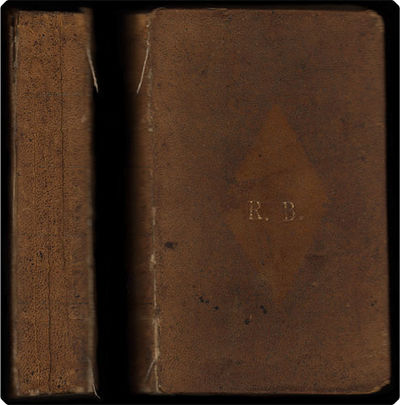
A new version of the Psalms of David. Fitted to the tunes used in churches.
Bible. O.T. Psalms. English. 1790. Tate & Brady. Boston, MA, 1790 Boston, MA: Pr. by Joseph Bumstead for David West & E. Larkin, Jun., 1790. 12mo (15.1 cm; 5.94"). 358, [2 (adv.)] pp. The Tate and Brady metrical translation of the Psalms succeeded, in 1696, the Sternhold and Hopkins version as that preferred for use in many of the parishes of the Church of England. It was sometimes published with the music, though not in the present Boston printing; included here are "Hymns, collected chiefly from Dr. Watts's hymns" (pp. 277–358), and a final leaf of bookseller's advertising. This copy of the popular hymnal was => owned by (at least) two musical clergymen (see below). Provenance: Front cover gilt-stamped "R. B[oyd]." Front pastedown with ex libris of the Rev. Frederick Lucian Hosmer (1840–1929), an American Unitarian hymn-writer and professor of hymnody, partially overlapping older armorial bookplate of the Boyd family; front free endpaper with bookplate of the Rev. Stanley Armstrong Hunter (1888–1959), author of Music and Religion and The Music of the Gospel, and pastor of first the North Presbyterian Church of Pittsburgh, PA and then St. John's Presbyterian Church of Oakland, CA. Evans 22351; ESTC W5075. Contemporary sprinkled sheep, covers each with diamond-shaped smooth and unsprinkled panel, front panel stamped "R.B." as above. Binding slightly cocked, acid-pitted and worn overall; spine leather showing cracks with both joints cracked and barely holding, back one reinforced inside some time ago; offsetting from turn-ins to early and late leaves. Bookplates as above, Boyd's with rubber-stamp of a religious institution (properly deaccessioned) overlapping its lower edge and Hosmer's with later inscription in pen of Stanley Astunler [?]. One leaf with closed tear into text without loss, another with lower outer corner torn away also without loss; general age-toning with one signature more noticeably browned and variable vut never more than "moderate" foxing throughout. => An obviously well-loved copy with pleasing provenance.- $450
- $450
Studies in early American history: A notable lawsuit.: https://rarebookinsider.com/rare-books/studies-in-early-american-history-a-notable-lawsuit/